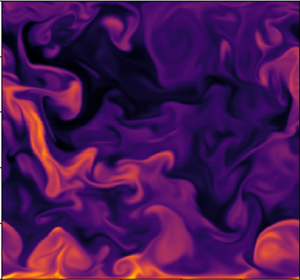Article contents
On the role of the Prandtl number in convection driven by heat sources and sinks
Published online by Cambridge University Press: 04 August 2020
Abstract

We report on a numerical study of turbulent convection driven by a combination of internal heat sources and sinks. Motivated by a recent experimental realisation (Lepot etal., Proc. Natl Acad. Sci. USA, vol. 115 (36), 2018, pp. 8937–8941), we focus on the situation where the cooling is uniform, while the internal heating is localised near the bottom boundary, over approximately one tenth of the domain height. We obtain scaling laws  ${Nu} \sim {Ra} ^{\gamma } {Pr}^{\chi }$ for the heat transfer as measured by the Nusselt number
${Nu} \sim {Ra} ^{\gamma } {Pr}^{\chi }$ for the heat transfer as measured by the Nusselt number  ${Nu}$ expressed as a function of the Rayleigh number
${Nu}$ expressed as a function of the Rayleigh number  ${Ra}$ and the Prandtl number
${Ra}$ and the Prandtl number  ${Pr}$. After confirming the experimental value
${Pr}$. After confirming the experimental value  $\gamma \approx 1/2$ for the dependence on
$\gamma \approx 1/2$ for the dependence on  ${Ra}$, we identify several regimes of dependence on
${Ra}$, we identify several regimes of dependence on  ${Pr}$. For a stress-free bottom surface and within a range as broad as
${Pr}$. For a stress-free bottom surface and within a range as broad as  ${Pr} \in [0.003, 10]$, we observe the exponent
${Pr} \in [0.003, 10]$, we observe the exponent  $\chi \approx 1/2$, in agreement with Spiegel's mixing-length theory. For a no-slip bottom surface we observe a transition from
$\chi \approx 1/2$, in agreement with Spiegel's mixing-length theory. For a no-slip bottom surface we observe a transition from  $\chi \approx 1/2$ for
$\chi \approx 1/2$ for  ${Pr} \leq 0.04$ to
${Pr} \leq 0.04$ to  $\chi \approx 1/6$ for
$\chi \approx 1/6$ for  ${Pr} \geq 0.04$, in agreement with scaling predictions by Bouillaut etal. (J. Fluid Mech. vol. 861, 2019, R5). The latter scaling regime stems from heat accumulation in the stagnant layer adjacent to a no-slip bottom boundary, which we characterise by comparing the local contributions of diffusive and convective thermal fluxes.
${Pr} \geq 0.04$, in agreement with scaling predictions by Bouillaut etal. (J. Fluid Mech. vol. 861, 2019, R5). The latter scaling regime stems from heat accumulation in the stagnant layer adjacent to a no-slip bottom boundary, which we characterise by comparing the local contributions of diffusive and convective thermal fluxes.
JFM classification
Information
- Type
- JFM Rapids
- Information
- Copyright
- © The Author(s), 2020. Published by Cambridge University Press
References
REFERENCES
- 15
- Cited by

